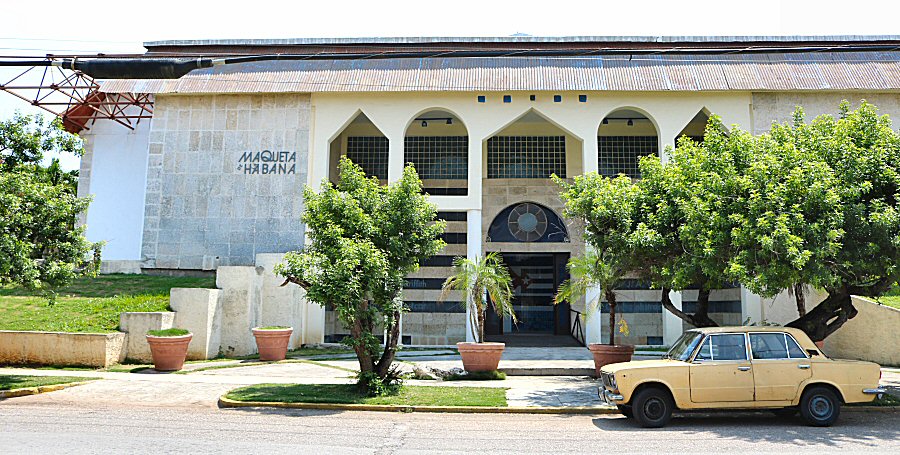
The Maqueta de la Habana is
located on the 28th street #113, between the st and 3rd Avenues
in Miramar.
Scale models are used all over the
world in urban planning. They help the architectures and the
urban planners, particularly of developing cities, to
understand how the city with all its surrounding will look
like in the future.
The scale models of Havana are on
display at two different places: the first one is on the
Mercaderes street in Old Havana and focuses on the Old
Havana, and the other one is in Miramar and it covers all
the city.
The 1:1000-scale model of Havana
is the third largest scale model on the world, after New
York and Shanghai respectively. It is about 22 meters long
and 10 meters wide, spanning over about 144 square meters.
It weighs about six tons. It was created by assembling 39
square boards, made of hardwood and plywood. They are
mounted on a metal frame with wheels. On each board about 4
square kilometer of the city is reproduced. The buildings
are made of cardboard and cedar wood; even cigar boxes are
used.
It was created according the
project of the Grupo para el Desarrollo Integral de la
Capital (GDIC; Group for the Integral Development of the
Capital) that was founded in 1987 to act as an advisory
committee on urban policies for the authorities of Havana
that would guide the development of Havana harmoniously and
would contribute to the urban awareness of institutions and
the population in general.
The project was carried out by a
team, consisting of nine members like designers, model
makers and architects. The team was led by Orlando Martorell
that joined the group in 1988. He was the head of the model
department of the Ministry of Construction for 25 years and
had also created the Maqueta de la Habana Vieja, the
1:1500-scale model of Old Havana. The architect Josefina
Rebellón and the model maker and sculptor Telmo Garcia took
charge in the team. The first board that was completed in
1988, was that of the municipality of Plaza de la Revolución.
They worked for eleven years to reproduce the capital in the
room by showing great care not to miss any detail. Thus,
they succeeded in creating something that looks like a map
more than a simple model of a region on the world. The scale
model was completed and inaugurated in 1995.
Strip barriers around the model
restrict the approach less than 1 meter, but the best view
can be obtained from the surrounding by proceeding on the
ramp. It allows the panoramic view of the scale model. There
are several binoculars, placed on the ramp, for the visitors
that would like to have a closer look at the city or would
search for a certain building or localization.
The model is also designed to give
the visitor an idea of the evolution of Havana by using
color codes. Consequently, the buildings that belong to the
different historical period are displayed through use of
different colors. Brown is used for the colonial period,
ochre for the Republican period and ivory for the period of
Revolution to the present day, whereas the sculptures,
cemeteries and the constructions that did not start yet, are
also incorporated into the model and represented in white.
The scale model is also illuminated to reproduce the city as
much as real.
The building of the
Maqueta de la Habana,
called as
pabellón (pavillion), has a modern
style. The façade is covered with jaimanite stone. The
columns are forming geometric figures at the top. The
building is accessed by a small bridge that reminds us the
draw bridge of an old castle. The lobby welcomes you with a
ceramic wall that simulates the waving of the Cuban flag,
and the white bust of José Martí. The expressive ceramic
mural, made by colored tiles, is the work of the Italian
designer Stellana Paleli. The back surface of the ceramic
mural is covered with the photos of some important buildings
of Havana and with the photos, demonstrating some
significant moments from the establishment of the GDIC and
the intensive work in the pabellón. In one of the photos,
Fidel Castro Rúz is visiting the GDIC.
The pabellón has a rather high
ceiling inside, and it occupies an area of about 900 square
meters. The space is utilized also for other permanent or
temporary exhibitions, postgraduate courses, conferences and
workshops, among others. Some regular activities are carried
out in the pavilion, such as conservation with some
personalities on city issues and competition among children.
The showcases of the permanent
exhibition are placed close to the walls surrounding the
model. They contain some interesting pieces. Short
information about them can be find on the list, hung on the
wall.
There are
also the 1:60- scale models of the Castillo de la Real
Fuerza and the Castillo de San Salvador de la Punta. Both
are made by Javier S. Martinez Morell in 2007 and 2008,
respectively. Burgundy colored pouffes, used in the
conferences, are rather pleasant. The walls are covered with
the photos of Havana from old times and its maps of
different scales.
The works of plastic art are
scattered around. The metal sculpture of Caballero de París
by Héctor Martínez Calá is one of the most attractive
objects in the building. It was sculpted by the artist in
1971 and in 1981 it was placed in Havana City Museum.

